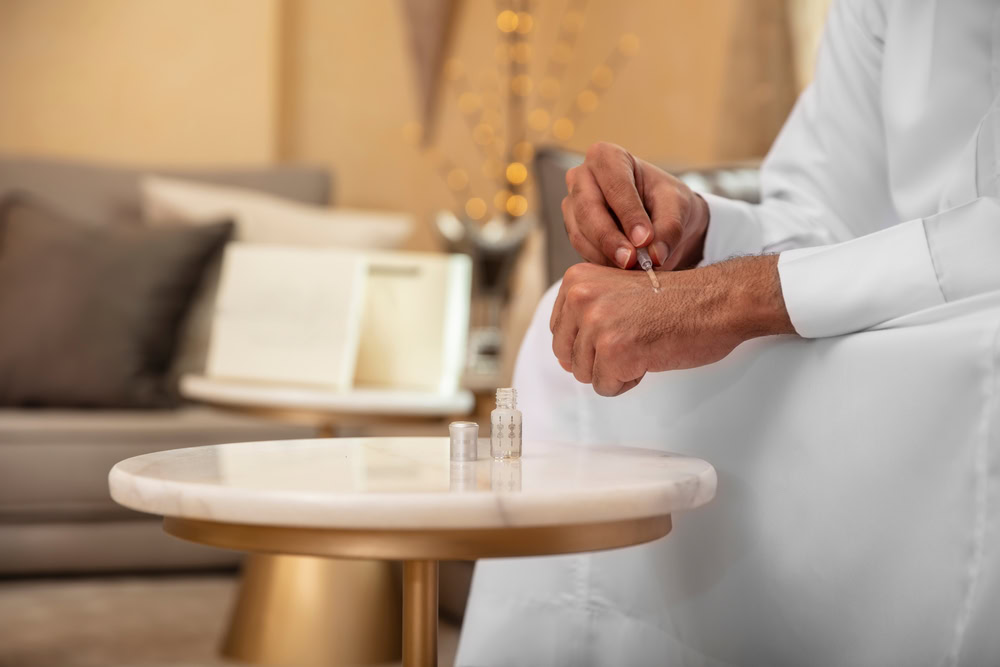Should Men’s Fragrance be Colorless?
Answered by Shaykh Irshaad Sedick
Question
Would you kindly clarify to me what this hadith means and how it’s understood from the perspective of men?
The Messenger of Allah (Allah bless him and give him peace) said, “The perfume of men is a scent without color, and the perfume of women is colored without scent.” [Tirmidhi; Nasa’i; Abu Dawud]
Does it mean that perfume for men shouldn’t have any color at all?
Some liquid perfumes have a color; even the typical Oud oils have an apparent color.
Answer
In the Name of Allah, the Most Merciful and Compassionate. May Allah alleviate our difficulties and guide us to what pleases Him. Amin.
This hadith highlights the preference for men to wear fragrances that are not visibly colorful (like Saffron) when applied to the skin or clothes but have a pleasant scent (like Musk or Amber). At the same time, for women, it is recommended to wear “fragrances” with color (like Henna to conceal beauty) while maintaining a moderate scent (when outside of her home, though she may wear any permissible fragrance for her husband). [Ibn Hajar, Fath al-Bari]
Prohibition of the Saffron Color for Men
In understanding this hadith, scholars emphasize the general guideline rather than a strict prohibition. The primary concern is to avoid ostentation or drawing undue attention when applying fragrance. It does not mean that men’s perfume (the liquid) must be completely colorless; instead, it suggests that men should opt for fragrances without a visible color, especially Saffron, which is impermissible for men to use and would imitate the practice of women.
Imam Tirmidhi (Allah have mercy on him) said: “What is meant by it being disliked for a man to use Saffron is for him to perfume himself with Saffron.” [Tirmidhi, 4/418]
Imam Shafi‘i (Allah have mercy on him) said: “We do not allow men, under any circumstances, to use Saffron, and if a man does use Saffron, we instruct him to wash the Saffron from his body.” [Ma‘rifat al-Sunan wa al-Athar, 2/455]
Imam Nawawi (Allah have mercy on him) said: “The reason for the prohibition [on Saffron] is the color, not the scent.” [Kashf al-Mushkil min Hadith al-Sahihayn, 3/271]
Many liquid perfumes have color, which is generally acceptable if the color is not feminine or attention-grabbing when applied. Oud oils, which often have an apparent color, are commonly used and accepted, as their primary purpose is to provide a pleasing scent rather than to be a means of adornment, and Allah knows best.
I pray this is of benefit and that Allah guides us all.
[Shaykh] Irshaad Sedick
Checked and Approved by Shaykh Faraz Rabbani
Shaykh Irshaad Sedick was raised in South Africa in a traditional Muslim family. He graduated from Dar al-Ulum al-Arabiyyah al-Islamiyyah in Strand, Western Cape, under the guidance of the late world-renowned scholar Shaykh Taha Karaan.
Shaykh Irshaad received Ijaza from many luminaries of the Islamic world, including Shaykh Taha Karaan, Mawlana Yusuf Karaan, and Mawlana Abdul Hafeez Makki, among others.
He is the author of the text “The Musnad of Ahmad ibn Hanbal: A Hujjah or not?” He has served as the Director of the Discover Islam Centre and Al Jeem Foundation. For the last five years till present, he has served as the Khatib of Masjid Ar-Rashideen, Mowbray, Cape Town.
Shaykh Irshaad has thirteen years of teaching experience at some of the leading Islamic institutes in Cape Town). He is currently building an Islamic online learning and media platform called ‘Isnad Academy’ and has completed his Master’s degree in the study of Islam at the University of Johannesburg. He has a keen interest in healthy living and fitness.
